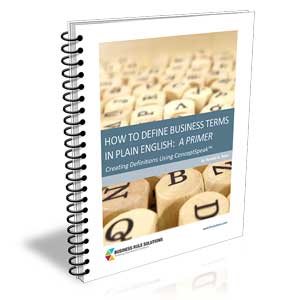What is an IGOE?
IGOE is an acronym for Input, Guide, Output, and Enabler. These are the basic components of any business process. The IGOE concept, like most things, is not completely new. It is based on the first detailed method for capturing and documenting process information. The original technique was called IDEF0, developed by the U.S. Department of Defense for the purpose of capturing the process of manufacturing fighter planes. Until this point there was no consistent structure or method for documenting processes. Since IDEF0 was created for the manufacturing industry, the terms and definitions developed were appropriately related to manufacturing. IDEF0 called the components of a process 'ICOMs'. ICOM is an acronym for Input, Control, Output, and Mechanism.
Since the "IGOE" concept was created for the purpose of documenting service-oriented processes, the terms and definitions were adapted to fit into service sector business. Considering that a significant number of the organizations in the world are service sector type organizations, it makes sense to have an approach for documenting and understanding process that is intentionally geared toward services.
Figure 1 gives an example of an IGOE template.

Figure 1. Example IGOE template.
Strict adherence to the definitions of each process component is critical if the IGOE technique is used to enhance process understanding and analysis.
An Input is defined as something that is transformed or consumed. The Inputs are not just things that flow through process/activity but are things that change or undergo a transformation. Hopefully, that transformation in some way adds value. Transformation types include physical, locational, and informational. Physical transformation occurs when something is changed in a literal, physical manner — for example, taking raw materials and transforming them into finished goods. Locational transformation occurs when the physical location of something is changed — for example, moving goods in a warehouse or moving goods from one warehouse to another location. Informational transformation occurs when the information is changed — for example, when information is created, updated, or deleted.
A Guide is defined as anything that describes the when, why, or how a process or activity occurs. Therefore the events that determine when a process begins or when it ends are classified as Guides, as well as all the policies, regulations, and any standards requirements. In addition, any reference information or data is considered to be a Guide, as well as any knowledge or experience used to help determine how the process/activity should occur.
Some examples of Guides include:
- Any type of starting and completion event related to the process, such as receiving or sending things or information,
- Any type of knowledge or experience needed to perform the activities in the process,
- Business Policies,
- Business Rules,
- Procedures,
- Acceptance / Completion Criteria,
- Culture,
- Performance Targets,
- Performance Criteria,
- Laws or Regulations,
- Any type of information used as reference material during the process,
- Experience.
Outputs are normally straightforward. Outputs are the product or result of the change that occurs to the Inputs or the result of the creation of something based on the Guides.
Finally, Enablers are the resources or assets required to transform an Input into an Output or to create Outputs. These resources include the people, systems, and tools and facilities utilized by an activity or process. Enablers include:
- Human Resources,
- Systems,
- Facilities,
- Tools,
- Equipment,
- Any type of reusable resource necessary.
It's critical for a complete understanding and analysis of process that these definitions are consistently applied. Without consistency, the understanding and accuracy of the analysis of the process will be compromised.
Example — Make a Peanut Butter and Jelly Sandwich

Figure 2.
Make a Peanut Butter and Jelly Sandwich

In Figure 2 — the example of making a peanut butter and jelly sandwich —the ingredients are the Inputs because they go through a physical transformation and become a sandwich. The hungry child can be considered an Input because the child goes through a transformation from hungry to happy. The emotional change is not usually documented unless it is critical to understanding the process.
The recipe and the child preferences are Guides because they provide the criteria for how to make the sandwich. Experience is also a Guide and is one of the Guides that organizations often forget but that can be critical to success when that experience leaves the organization. The events of "hungry child" and "satisfied child" are Guides because they indicate when the activity begins and ends, setting the boundaries.
The Enablers are the Mom/Dad because we need someone to make the sandwich. The knife, fork, and spoon are Enablers because they are the tools used to access the ingredients. The main Output is the sandwich, which is the product of the ingredients.
Example — Fill Car with Gas

Figure 3.
Fill Car with Gas

In Figure 3 — the example of filling the car with gas —the car and money are Inputs and Outputs because they both go through a transformation: the car from dirty to clean, the money changes in quantity.
The events of "pull up to the gas pump" and "drive away" set the boundaries for the process and guide when the activity begins and ends. The criteria for how much gas is put in the gas tank include the tank capacity, gas filling rules, budget, and limit on charge or amount of money. The Guide for what kind of gas is the grade of gas.
The Enablers are the person who puts the gas in the car, the gas pump that provides the means for getting the gas into the car, and the gas station that provides the facility for storing the gas until it's used. These are Enablers because the car could not be filled with gas without these resources or assets.
Example — Pay Cell Phone Bill

Figure 4.
Pay Cell Phone Bill

In Figure 4 — the example of paying a cell phone bill — the Excel spreadsheet and the cell phone bill are Inputs and as well as Outputs. This activity has an additional Output of payment. This is an example of an Output that has been created based on the Inputs and the Guides.
The starting and ending events are Guides because they indicate when the activity begins and ends. The business rules for paying the phone bill are contained within the various company policies. The cell phone bill is also a Guide because some of the information on the bill determines whether the bill gets paid or is rejected, and the Excel spreadsheet is a Guide because it serves as the set of requirements for the information that management wants captured on each cell phone bill.
The Enablers are the resources that fulfill roles in the activity. The Excel spreadsheet is an Enabler as a template that needs to be filled out, and the PC is an asset that has Excel loaded onto it.
The So-What Test
When advocating one particular approach over another, that approach needs to pass the "so-what" test — simply stated, "Why does it matter?" To avoid falling into the trap of doing something differently just to do it differently, it's important to understand the advantages of using the IGOE approach to capture and to analyze processes.
Separating the components of a process into Input, Guide, Output, and Enabler allows the analyst to focus on specific aspects of a process. For example, by strictly adhering to the definition of an Input as something that gets changed or transformed in some manner, an analyst can very clearly determine where value is created in the process, since value can only be created through a transformation of some kind. It also provides very clear definitions of where information is created, referenced, updated, and deleted (CRUD).
Statistics from research and practice indicate that about 80-85% of the opportunities to significantly impact the performance of a process result from changes to the elements in the Guide category. Therefore, it becomes very important to focus on the information in this category as one of a project's highest priorities. This is information that is often ignored or sidelined as unchangeable since it includes policies and procedures that have often become so ingrained in an organization that they actually represent the culture of the organization. Yet, when carefully and objectively analyzed, it is changes to a company's policies that can generate literally thousands of percent improvement in the efficiency of processes — for example, a reduction in cycle time from 15 days to 45 minutes for the payment cycle, or 10 days to 2 days for the installation of a new server. However, when this information is cluttered together with elements of Inputs and other types of data such as systems information or data storage references, it becomes lost and is normally not exposed in the understanding or analysis of the process. The net result is that organizations are often examining, analyzing, and improving only 15% of their opportunities, leaving 85% on the table untouched. This is like someone giving us a dollar in savings and we take only 15 cents and leave the other 85 cents untouched.
Separating the components of a process into the four categories of Input, Guide, Output, and Enabler also provides an analyst with the opportunity to examine more closely the relationships between these elements. For example, for every Enabler there should be an associated Input, Guide, or Output. If not, then why not? For every Input there should be an Output or an understanding of what happened to make the Input disappear. For every Output there should be an Input or a Guide — if not then how did the Output get created? From a measurement perspective it's very useful to examine the measurements for the Inputs verses the Outputs. For example, in the process of educating students, if the number of students coming out is less than the number of students going in, what happened? Where did the education system lose them and why? The awareness of this difference by a superintendent of a large school district led to several changes in the processes of his school system. The result was a reduction in this number. In addition, his school was presented with the Baldridge award for process excellence.
Summary
Using the IGOE approach is not about classifying for the purpose of classifying or pigeon holing information. It's about understanding the processes better and being able to analyze the processes for opportunities more easily and effectively. It's about making incredible improvements to processes that most organizations miss. It's about getting truly incredible results and payoffs from the investment of time and resources allocated to process improvement.
# # #
About our Contributor:
Online Interactive Training Series
In response to a great many requests, Business Rule Solutions now offers at-a-distance learning options. No travel, no backlogs, no hassles. Same great instructors, but with schedules, content and pricing designed to meet the special needs of busy professionals.











How to Define Business Terms in Plain English: A Primer
How to Use DecisionSpeak™ and Question Charts (Q-Charts™)
Decision Tables - A Primer: How to Use TableSpeak™
Tabulation of Lists in RuleSpeak®: A Primer - Using "The Following" Clause
Business Agility Manifesto
Business Rules Manifesto
Business Motivation Model
Decision Vocabulary
[Download]
[Download]
Semantics of Business Vocabulary and Business Rules